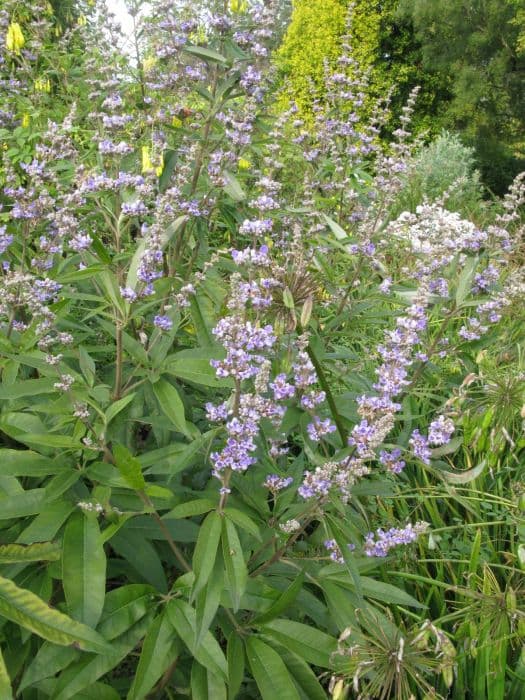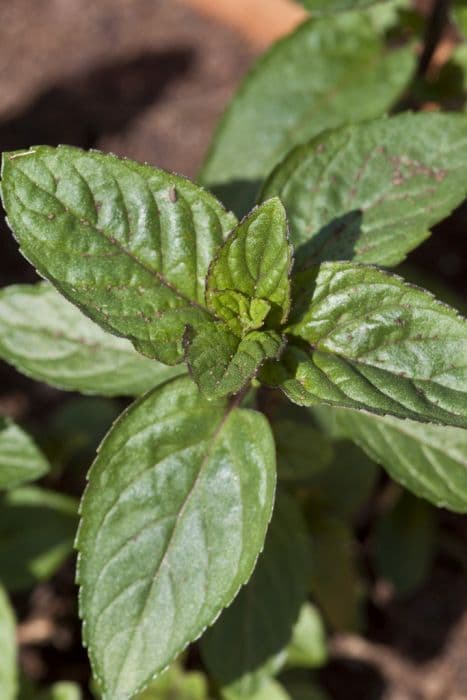Bowles' mint Mentha × villosa var. alopecuroides Bowles's mint

ABOUT
Bowles's mint exhibits a lush and vigorous growth habit, characterized by its spreading nature that allows it to form dense and attractive patches. This mint variety has a distinctive appearance, primarily due to its textured foliage and notable aromatic quality. The leaves are often a rich green color and may have a slight downy texture, giving them a soft and fuzzy feel when touched. They are typically rounded to ovate in shape and boast a serrated edge that adds to their tactile interest. Throughout the growing season, Bowles's mint may develop small, lilac, or pale purple flowers that grow in whorls around the square stem, a feature common in many mint species. These flowers can attract pollinators, such as bees and butterflies, adding a dynamic element to its presentation. The scent of the plant is a strong minty aroma that pervades the surrounding space, intensifying when the leaves are crushed or rubbed, releasing the essential oils contained within. Overall, the visual and olfactory appeal of Bowles's mint makes it a favored choice for both garden aesthetics and culinary uses.
About this plant
 Names
NamesFamily
Lamiaceae
Synonyms
Bowles's Mint, Apple Mint, Cuban Mint, Mojito Mint, Woolly Mint
Common names
Mentha × piperita subsp. citrata, Mentha citrata, Mentha odorata
 Toxicity
ToxicityTo humans
Bowles's mint is generally considered non-toxic to humans and is often used in culinary applications for flavor. However, as with many plants, consuming it in excessive amounts could potentially cause gastrointestinal discomfort or allergic reactions in sensitive individuals.
To pets
Bowles's mint is not typically toxic to pets. Like in humans, ingestion in normal culinary amounts is unlikely to cause harm. Nonetheless, overconsumption could lead to minor digestive upsets in some animals, particularly those with sensitive stomachs or those not accustomed to this plant in their diet.
 Characteristics
CharacteristicsLife cycle
Perennials
Foliage type
Deciduous
Color of leaves
Green
Flower color
Varies
Height
2 feet (0.6 meters)
Spread
2 feet (0.6 meters)
Plant type
Herb
Hardiness zones
5
Native area
Cultivar
Benefits
 General Benefits
General Benefits- Culinary Uses: Bowles's mint can be used to flavor a variety of dishes, including salads, beverages, and desserts, with its fresh, minty taste.
- Aromatic: The plant emits a pleasant fragrance which can be enjoyed in the garden or when used fresh in bouquets and arrangements.
- Attracts Pollinators: Bowles's mint flowers are attractive to bees, butterflies, and other beneficial insects, which can help to pollinate your garden.
- Garden Design: With its vibrant green foliage, Bowles's mint can be used effectively for border planting, container gardening, or as ground cover.
- Culinary Garnish: The leaves of Bowles's mint make an attractive and edible garnish for a variety of dishes, enhancing presentation and flavor.
- Companion Planting: It can be planted alongside other herbs and vegetables as part of a companion planting strategy to promote a healthier garden ecosystem.
 Medical Properties
Medical Properties- Mentha × villosa var. alopecuroides, commonly known as Bowles's mint, may contain menthol, which is known for its potential analgesic and cooling effects.
- The menthol content also can impart antispasmodic properties, potentially helping to relax muscle tension and alleviate gastrointestinal discomfort.
- Its essential oil might possess antimicrobial properties that could help in fighting certain bacteria and fungi.
- As with many mint species, Bowles's mint could have potential uses for alleviating symptoms of the common cold, such as congestion and throat irritation.
- The plant may have carminative effects, possibly aiding in the reduction of gas and bloating.
 Air-purifying Qualities
Air-purifying QualitiesThis plant is not specifically known for air purifying qualities.
 Other Uses
Other Uses- Mentha × villosa var. alopecuroides, commonly known as Bowles's mint, is often used as a natural pest repellent in gardens due to its strong scent that is unappealing to many insects.
- The crushed leaves of Bowles's mint can be rubbed on skin as a traditional remedy for insect bites to help soothe irritation and reduce itching.
- Bowles's mint can be planted in containers or hanging baskets to provide a refreshing minty aroma to outdoor living spaces.
- The essential oil derived from Bowles's mint has been used in homemade cleaning products for its antibacterial properties and fresh scent.
- Gardeners may use Bowles's mint as companion plants to deter pests away from vegetable crops or roses without the use of chemical pesticides.
- Dried leaves of Bowles's mint have been used in potpourri mixes to impart a long-lasting fragrance to rooms and closets.
- Bowles's mint can be included in floral arrangements for its aromatic leaves and delicate flowers, adding both scent and a touch of greenery.
- When dried, Bowles's mint leaves can serve as a natural moth deterrent, particularly when stored among woolen garments.
- Animals such as cats and dogs are sometimes deterred from digging in garden beds or urinating on lawns by planting Bowles's mint around the area.
- As a culinary herb, Bowles's mint is used to flavor a plethora of dishes, ranging from desserts and beverages to savory sauces and marinades.
Interesting Facts
 Feng Shui
Feng ShuiBowles's mint is not used in Feng Shui practice.
 Zodiac Sign Compitability
Zodiac Sign CompitabilityBowles's mint is not used in astrology practice.
 Plant Symbolism
Plant Symbolism- Healing: Bowles's mint, like many mint varieties, has been associated with healing properties due to its medicinal uses. It symbolizes the ability to soothe physical and emotional ailments.
- Refreshment: Its cool and refreshing flavor makes it a symbol of invigoration and renewal.
- Hospitality: Historically, mint has been used to welcome guests, symbolizing hospitality and camaraderie.
- Protection: Mint is also believed to repel negative energy and protect against harm, thus symbolizing safety and security.
- Purification: Due to its clean and sharp scent, Bowles's mint represents cleanliness, purity, and the clearing of obstacles or negative influences.
 Water
WaterBowles's mint prefers consistently moist soil, so it's important to water it when the top inch of soil feels dry. Typically, this might require watering once or twice a week, depending on climate conditions and the plant's environment. However, be careful not to overwater, as mint plants do not like soggy soil. It's best to use the soak and dry method, allowing water to reach deep into the roots. For an average-sized pot, you might use about half a gallon of water every week during the growing season, adjusting based on temperature and rainfall.
 Light
LightBowles's mint thrives in full to partial sunlight. The ideal spot would offer at least 4 to 6 hours of direct sunlight daily. However, in hotter climates, some afternoon shade can be beneficial to prevent the leaves from scorching. If growing indoors, place Bowles's mint near a sunny window where it can receive ample light.
 Temperature
TemperatureBowles's mint grows best in temperatures ranging from 55 to 70 degrees Fahrenheit. It can withstand temporary dips down to about 50 degrees but will suffer if exposed to frost. Conversely, extreme heat above 80 degrees can stress the plant. Keeping Bowles's mint in the given temperature range will ensure healthy growth.
 Pruning
PruningPrune Bowles's mint to encourage bushier growth and prevent legginess. It's best to do this in the spring and throughout the growing season as needed. Regular harvesting of the leaves for culinary use also serves as a form of pruning. Avoid heavy pruning in late fall to allow the plant to prepare for winter.
 Cleaning
CleaningAs needed
 Soil
SoilBowles's mint prefers rich, moist but well-draining soil with a pH ranging from 6.0 to 7.0. A good soil mix for Bowles's mint can be made by combining two parts peat or coco coir, one part perlite or vermiculite for aeration, and one part compost for added fertility.
 Repotting
RepottingBowles's mint should be repotted every one to two years to refresh the soil and accommodate its fast growth. This plant is known for its vigorous growth habit and can quickly become root-bound.
 Humidity & Misting
Humidity & MistingBowles's mint thrives best in environments with moderate to high humidity levels. Keep the humidity around the plant at 40-50% for optimal growth.
 Suitable locations
Suitable locationsIndoor
Provide bright, indirect light and keep soil moist for Bowles's mint.
Outdoor
Place in partial shade to full sun; keep soil consistently moist for Bowles's mint.
Hardiness zone
5-9 USDA
 Life cycle
Life cycleBowles's mint, a perennial herb, begins its life cycle when seeds germinate in warm, moist soil, typically in the spring. Germination leads to the emergence of seedlings, which establish a root system and develop leaves during the vegetative growth phase. As the plant matures, it enters the flowering stage, characterized by the production of small, aromatic flowers that attract pollinators; this typically occurs in late spring to summer. Following pollination, the plant produces tiny seeds that can disperse to propagate new plants. Throughout its life cycle, Bowles's mint vigorously spreads by stolons, or runners, which root at nodes to create new clumps and expand its growth. The plant may die back in winter in colder climates but will regrow from the roots or overwintering stolon nodes with the return of warm weather.
 Propogation
PropogationPropogation time
Spring to Summer
Bowles's mint, known scientifically as Mentha × villosa var. alopecuroides, is most commonly propagated through vegetative means, specifically by stem cuttings. This method is popular due to its ease and efficiency. To propagate Bowles's mint using stem cuttings, one would take a healthy stem of about 4 to 6 inches (approximately 10 to 15 centimeters) in length, making sure that it has several sets of leaves. The lower leaves are removed, and the cut end of the stem is often dipped in a rooting hormone before being placed in a moist growing medium such as potting soil or a water-based rooting environment. The cutting is then kept under favorable conditions, with high humidity and indirect sunlight until roots develop, which typically takes a few weeks. After rooting, the new plant can be transplanted to its final growing location. This technique is most successful when performed in the spring or early summer when the plant is actively growing.









